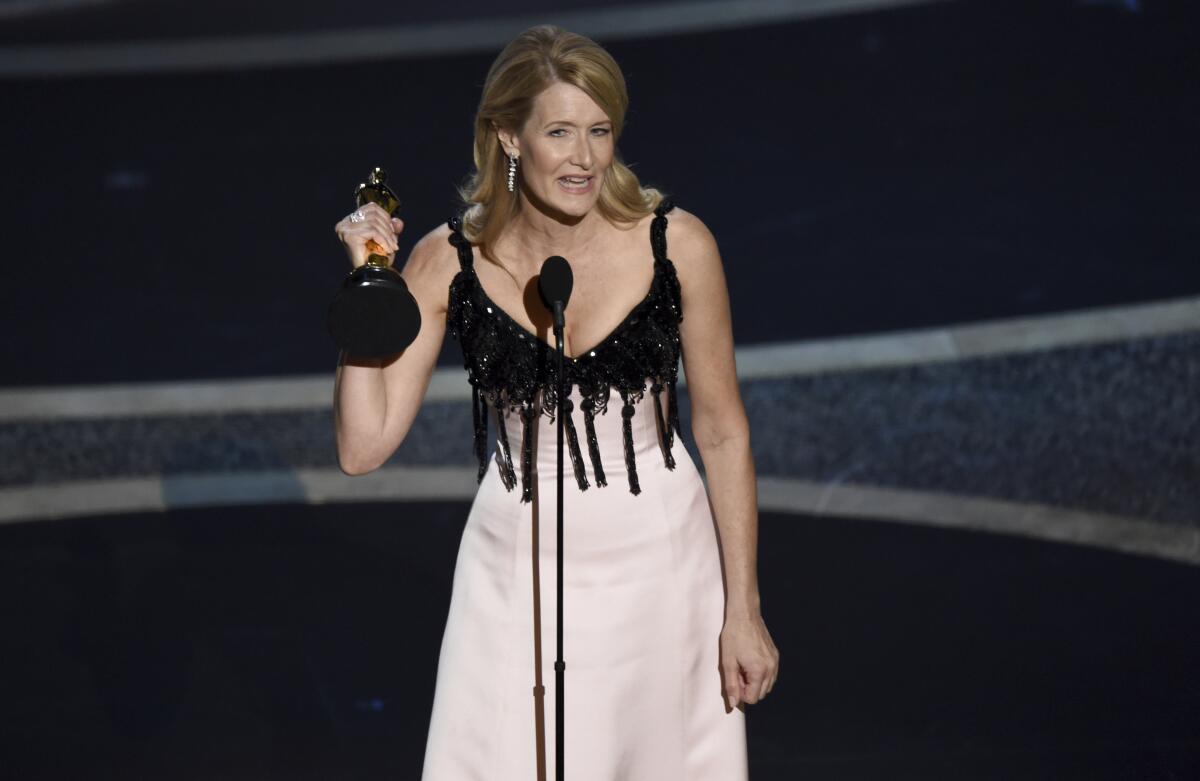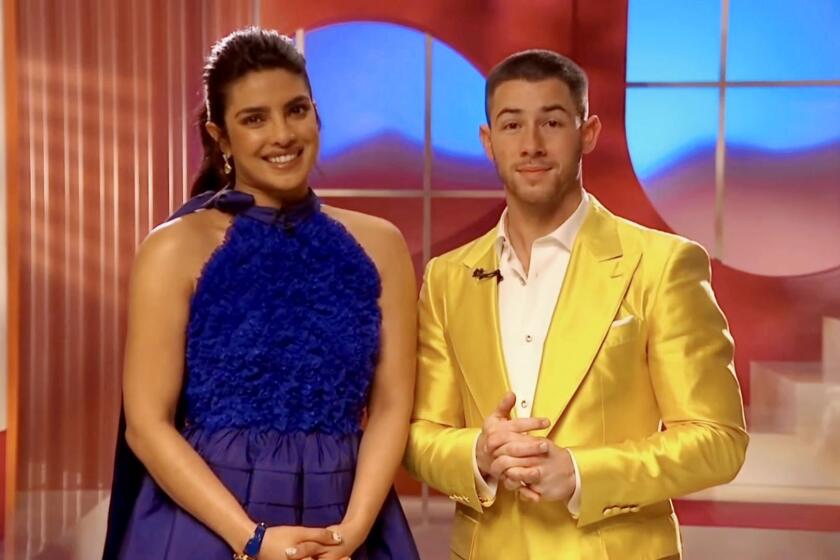Awards shows are struggling to draw TV audiences. Should the Oscars be worried?

- Share via
For decades, awards shows provided a front-row seat to TV viewers’ favorite performers.
Even as audiences for sitcoms and dramas were siphoned away by streaming services, the Oscars, the Grammys and the Golden Globes could be relied upon every year to deliver the biggest TV ratings outside of NFL football.
But over the past year, awards shows could not catch a break as the pandemic turned the spectacles into low-key, socially distanced and often virtual affairs. Both the CBS telecast of the 63rd Grammy Awards (9.2 million viewers on March 14) and NBC’s presentation of the 93rd Golden Globe Awards (6.9 million viewers on Feb. 28) dropped more than 50% from 2020 levels, according to Nielsen.
The Emmy Awards — already in a ratings tailspin in recent years as it no longer celebrates mass-appeal hits — showed how far audience levels can drop, sinking 9% to 6.1 million viewers Sept. 20 on ABC. Other shows, such as the American Music Awards, the Country Music Assn. Awards and the Billboard Music Awards, hit all-time lows as well.
The downward trend has dampened the expectations for ABC’s April 25 telecast of the Oscars, which is coming off a historic audience low last year when 23.6 million people watched. TV executives are predicting this year’s figure to be in the range of 12 million to 15 million viewers for the live ceremony, which still ranks as the most-watched entertainment program of the year.
If the ratings of TV awards shows don’t bounce back after pandemic restrictions ease, the events could become an expensive problem for the networks carrying them.
Some veteran TV executives believe the fragmented nature of entertainment, with so many choices available on streaming services, has made it harder to aggregate the kind of large audiences the events once delivered.
“I think award shows have got a patina like a candlestick that is 100 years old and all the polish in the world is not going to bring it back,” said Ted Harbert, a former president of NBC and ABC.
Even before the pandemic, awards show viewership had been in decline, but not at the dramatic pace seen for scripted series. Based on the relative strength of the telecasts, ABC, CBS and NBC all agreed to pay hefty license fees in long-term deals in recent years to carry the awards shows.
Major live events that attract mass audiences are valuable to advertisers who want viewers to see their commercials. The shows also provide networks with a promotional platform for other programming.
2021 Oscar nominations: The complete list
In 2016, the Walt Disney Co.’s ABC signed a massive 10-year deal that will pay the Academy of Motion Picture Arts and Sciences more than $1 billion for the broadcast rights for the Oscars through 2028. The network has been home to the Oscars since 1976.
CBS is in the middle of a 10-year deal that in recent years has paid the Recording Academy around $57 million annually for the Grammy telecast rights. This year’s take in ad revenue for the program is likely to fall short of the $66 million the network pulled in during 2020, according to Standard Media Index.
CBS chased the Golden Globe Awards when they became available in 2018, forcing NBC to nearly triple its annual fee. NBCUniversal agreed to pay the Hollywood Foreign Press Assn. and Dick Clark Productions nearly $60 million a year through 2026 for rights to televise the show — up from about $21 million a year in 2018. It turned the event into a loss leader for the network.

NBC went into 2021 expecting the Golden Globes to be in the red. SMI data showed the network took in $33.8 million in ad revenue for the program — down 26% from the previous year.
(The HFPA — currently under fire over the lack of diversity in its membership — gave NBC a $20 million rebate to alleviate the loss, according to a person familiar with the deal who was not authorized to comment. The network declined to comment.)
ABC is anticipating a revenue decline of $15 million to $20 million for this year’s Oscars telecast, said a person familiar with the discussions who was not authorized to comment
Last year, ABC took in $108.8 million in national TV ad revenue for the Oscars, according to SMI data. Disney also sees ad revenue from sales at the TV stations it owns and the live stream on Oscars.com, and is compensated for distributing the telecast internationally.
Doug Hochstadt, senior vice president of revenue management for Disney Advertising Sales, said that even with an anticipated decline in the size of the audience for this year’s Oscars, the network has managed to stay close to its previous ad rates thanks to multiyear deals with some advertisers. The network does not guarantee the size of the audience to companies that in the past have paid as much as $2 million for a 30-second spot.
“The Oscars is special — it’s about the quality of the audience and who is watching and attentiveness level,” Hochstadt said. “They are viewers who don’t come to TV all the time. There are only a few places to reach them, and the Oscars is still one of those places.”
According to the most recent financial statement for the Academy of Motion Picture Arts and Sciences, ABC is scheduled to pay $119 million for the Oscars this year and $124 million in 2022.
Asked about the challenges facing the telecast this year, Rob Mills, executive vice president of unscripted and alternative entertainment for Walt Disney Television, said: “The Oscars is the gold standard, so we will always find unique and surprising ways to deliver an evening that celebrates the movies that connect us, and we’ll do it in a way that also thoroughly entertains viewers at home.”
But it’s clear that this year’s Oscar telecast producers, Steven Soderbergh, Stacey Sher and Jessie Collins, are attempting to avoid the limitations of a virtual show. Oscar nominees were informed last month in an email that they will not have the option of accepting an award via Zoom and must attend the ceremony being held at Union Station and the Dolby Theatre in order to participate in the festivities.
“We are going to great lengths to provide a safe and ENJOYABLE evening for all of you in person, as well as for all the millions of film fans around the world, and we feel the virtual thing will diminish those efforts,” the email said.
Executives at the networks, who were not authorized to discuss the situation publicly, cited the use of Zoom and the lack of a live audience due to health protocols as the principal culprits for the ratings declines of other awards shows this year.
“Don’t underestimate what an audience brings,” said one veteran network executive who has been involved with a number of awards shows. “The audience creates an image for viewers that makes them feel like they are being at an event that they could not get a ticket for.”
Interest in this year’s events has been hurt by the pandemic’s curtailment of moviegoing in theaters and live touring by musical artists. With many workplaces closed, there also has been far less water-cooler conversation about movies, TV and music.
The answer as to whether this year’s pronounced dip is temporary may not come until 2022 or 2023 — whenever audiences can return to movie theaters and concerts on a large scale.
“Once you’ve broken the habit, it’s hard to get them back,” said Preston Beckman, a media consultant formerly with Fox and NBC.
The disruption that occurred with the pandemic comes on top of the seismic shifts in viewing habits that have diminished the tradition of sitting through a live, three-hour-plus awards telecast.
The Oscars scored a robust audience of 42 million viewers in 2014 when Ellen DeGeneres served as emcee.
Since that year, the number of people who tune in to watch live broadcast and cable TV has been on a steady decline as the popularity of streaming has exploded. In the 2015-16 season, the average percentage of people watching TV in prime time was 35.7%, according to Nielsen. In the 2020-21 season, the figure is 25.3%.
The decline is even steeper among viewers ages 18 to 49, the demographic group desired most by advertisers. In 2015-16, an average of 29.6% of that group was watching in prime time. In the current TV season, it’s down to 16.2%.
“Younger viewers are simply not watching linear television,” said Harbert.
During the pandemic, more older viewers have discovered streaming, which could further cut into traditional TV viewing.
Social media also has chipped away at awards show viewing. Real-time reporting across various platforms reveals the winners, speech highlights, audience reactions and what designer clothes are being worn on the red carpet.
Twitter, Facebook and Instagram have further diminished the mystique of many stars, some of whom give fans a steady diet of mundane information on their lives, making the portal that awards shows provided superfluous.
Additionally, while there is no way to quantify the impact on viewing, networks have conducted research showing some audience members don’t want to hear stars presenting their political positions on the programs.
Although stars have used the Oscars as a political forum going back to the time when Marlon Brando sent a Native American activist to the stage to refuse his best actor award in 1973, today’s politically polarized audience has plenty of other viewing options.
The Oscars also have had to contend with academy members favoring smaller, niche-appeal films in recent years, and history has shown that the public is more invested in the telecast when it celebrates broad-based successes. (The Oscars audience grew 12% in 2019 when “Green Book” and “Black Panther,” both box office hits, had multiple nominations.)
This past year, the contenders for best movie such as “Nomadland,” “Minari” and “Mank” found passionate but small audiences. Streaming platforms were their primary means of distribution, which means they had to compete with thousands of other TV shows and films for the public’s attention.
Times Staff Writer Meg James contributed to this report.
More to Read
Inside the business of entertainment
The Wide Shot brings you news, analysis and insights on everything from streaming wars to production — and what it all means for the future.
You may occasionally receive promotional content from the Los Angeles Times.












